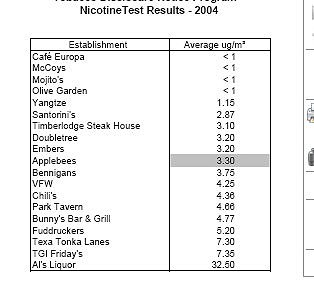Your opinion please......
I was recently having a discussion with a group who thought that the St. Louis Park / OSHA air quality data was too much information for lawmakers to digest........I disagreed.Am I giving lawmakers too much credit? Do they not have the attention span to digest these results? (In other words does anybody not understand the test results below?)
Send me an email (from my profile link above) or leave a comment......
Since some people seem to have difficulty in seeing the importance of comparing the St. Louis Park Environmental Health Department secondhand smoke air quality test results to the OSHA guidelines, here it is side by side:

click to enlarge 1 milligram mg = 1,000 micrograms ug (full OSHA table can be found here)

click to enlarge (actual SLP results found here)
The upper table is the actual OSHA permissible exposure limit table for airborne contaminants ie. these levels are the safe exposure limits for humans. You'll note that the nicotine* safe level is 0.5 milligrams mg / cu. M (same as 500 micrograms (ug) / cu. M).
The bottom table is the actual St. Louis Park test results for 19 establishments of measured airborne nicotine* levels. You can see the median establishment, Applebees, had a reading of 3.3 micrograms ug / cu. M.
500 ug (OSHA safe level) divided by 3.3 ug (median reading Applebees) = measured airborne nicotine* levels are 152 times safer than OSHA regulations. In other words NO HEALTH HAZARD as per OSHA workplace indoor air quality standards.
It is therefore disingenuous to implement smoking bans based on the argument that secondhand smoke is a health hazard, that argument has been scientifically proven false.
* (As per air quality researchers, universally accepted) Nicotine is the only unique or "trace" chemical in secondhand smoke. If you measured for formaldehyde, the carpet and other interior sources of formaldehyde would corrupt the test result, formaldehyde is formed naturally in our atmosphere due to photochemical oxidation. Benzene is given off from burning foods in the kitchen or diesel exhaust outdoors so again a false reading would be obtained. Therefore, nicotine is the ideal chemical to measure for to determine secondhand smoke concentrations in the air. And then our comparison to OSHA guidelines is the logical manner in which to determine if secondhand smoke levels pose a health hazard, as you can see, they do not. If you wanted you could measure every airborne chemical in secondhand smoke and then also compare them to OSHA guidelines for that specific chemical, the results would be the same if not more dramatic.



 "Though we may not be able to protect your business property rights, we certainly support your Second Amendment Rights"
"Though we may not be able to protect your business property rights, we certainly support your Second Amendment Rights" 

<< Home